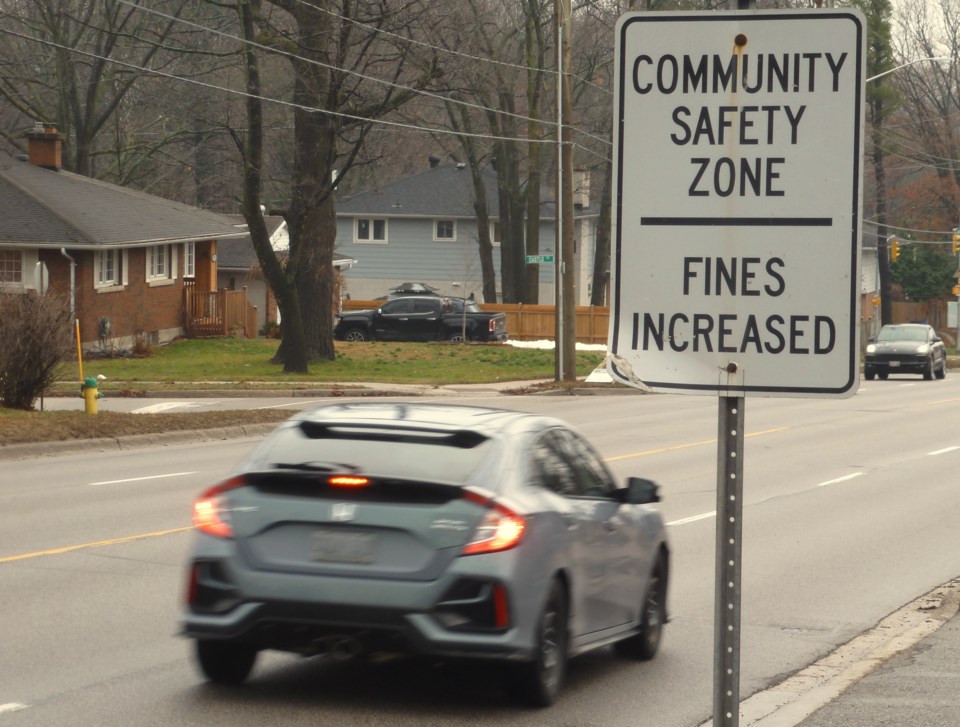City council gave final approval Monday night to work toward operating two mobile speed cameras in community safety and school zones in all 10 Barrie wards.
The motion asks that operations department staff inform Toronto’s Joint Processing Centre that Barrie seeks to participate in the Automated Speed Enforcement (ASE) program, which uses a camera and a speed measurement device to detect and capture images of vehicles travelling faster than the posted speed limit and is effective in reducing collisions in school and community safety zones.
Staff would report back with details concerning the next steps of implementation required for the installation, operations and maintenance costs of the cameras and related signs, Joint Processing Centre operating costs and provincial costs.
A pilot program of two mobile cameras is being recommended by staff, at an approximate cost of $70,000 to $80,000 annually.
Implementing the ASE program could take as long as two years, or even longer, because of the number of steps in the process.
About four years ago, city council approved a motion that should new provincial legislation empowering municipalities to install safety cameras in community safety zones and school zones to help protect school children, seniors, pedestrians and cyclists be passed, operations and legislative staff, and in court services, would report back to Barrie councillors with the requirements and implications associated with implementing such a program.
The next year, the province passed the Safer School Zones Act, 2017 to permit municipalities to implement automated speed enforcement technology in school and community safety zones. The legislation and the associated regulations came into force Nov. 29, 2019.
The ASE system has three main components - speed measurement, data processing and storage, and image capturing that includes a data box with the posted speed limit, the speed of the vehicle, the location, the time of day, etc. If a vehicle exceeds the posted speed limit in an ASE-enforced area, the system captures an image.
Images are reviewed by Provincial Offence Officers at the Joint Municipal Processing Centre, which is operated by the City of Toronto. It is the only violation processing centre in Ontario for ASE enforcement. Municipalities pay Toronto to process evidence, issue offence notices and prepare court documents, on the basis of a cost-sharing formula.
The ticket contains a digitized copy of the image and an enlargement of the plate portion. It is mailed to the registered plate holder within 30 days of the offence, outlining next steps and the cost of the associated fine. The registered licence plate holder gets the ticket, whether or not he or she was driving the vehicle at the time. There is a fine for those convicted, but demerit points aren’t issued and the registered owner’s driving record isn’t affected.
Fines could range from $21 for going one km/h over the posted speed limit to $1,105-plus for 50 km/h or more.
School zones are designated road areas near schools, and typically occur within 150 metres of the front of a school and have reduced speed limits during specific periods of the day.
City council policy mandates a 40 km/h posted speed limit in front of elementary schools, as well as for roadways where – due to their geometric design – there is an increased probability of danger when a car drives at 50 km/h or faster. On major roads where there are elementary schools, a ’40 km/h when flashing’ speed limit is in effect.
Barrie has these speed limits – which follow varying time schedules – in 23 elementary school locations.
Community safety zones are established by municipal council through a bylaw, and cover road areas where there is a higher risk to, or concern for, drivers, pedestrians, cyclists and/or others who share the space. Highway Traffic Act fines, including speeding, are doubled in community safety zones and many community safety zones are located close to schools.
Barrie has more than 75 sections of road designated as community safety zones, according to the Community Safety Zones Bylaw.

